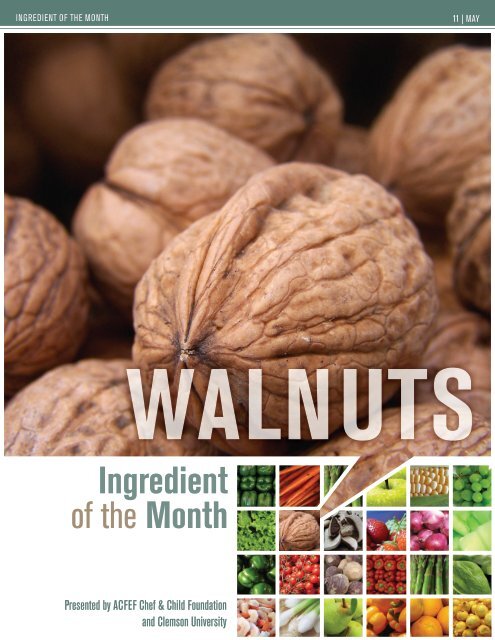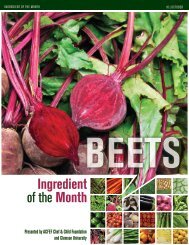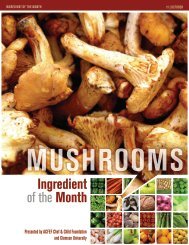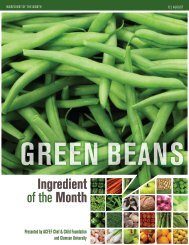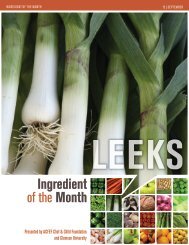Walnuts - American Culinary Federation
Walnuts - American Culinary Federation
Walnuts - American Culinary Federation
- No tags were found...
You also want an ePaper? Increase the reach of your titles
YUMPU automatically turns print PDFs into web optimized ePapers that Google loves.
Ingredient of the Month11 | MaywalnutsIngredientof the MonthPresented by ACFEF Chef & Child Foundationand Clemson University
Ingredient of the Month11 | may<strong>Walnuts</strong> have been cultivated for millennia and areconsidered the oldest tree food known to man. The fruit of thewalnut tree grows in temperature zones throughout the world.Early history indicates that walnuts came from ancient Persia;thus, the walnut is often referred to as the “Persian walnut.”Romans referred to walnuts as Juglans regia or “Jupiter’s royalacorn” and spread them into North Africa and Western Europe,and as far north as England, where they assumed the name“English walnuts.” To this day, English walnuts are considered themost widely available and cultivated variety.Another common variety is black walnuts, which are native to theUnited States and are grown from New England to Minnesotaand to Florida. Black walnut trees were important to Native<strong>American</strong> Indians who relied on their dyes, their bark and leavesas healing agents and utilized nuts as a food source. Today, theleading commercial producers of walnuts are the United States,Turkey, China, Iran, France and Romania.The edible portion of walnuts is protected by an outer shell,which helps maintain the quality of the nut. With their crunchytexture and nutty, slightly sweet flavor, walnuts are deliciousin a wide variety of sweet and savory dishes, from salads tosoups and from ice cream to pastries. They’re also used tomake fragrant, flavorful oil. Classic flavor pairings with walnutsare bananas, dried fruits, cream cheese and blue cheese. Whilefall is harvest season for walnuts, they are available shelled, inhalves or in pieces year-round. They also contain significantantioxidants, omega-3 fatty acids and vitamin E, making them anutritious and versatile food.Healthy ingredient contributionVitamin E: <strong>Walnuts</strong> contain Vitamin E in the gammatocopherolform, which can aid in men’s cardiovascularhealth. Vitamin E also functions as an antioxidant.Phytonutrients: <strong>Walnuts</strong> are a sourceof phytonutrients (organic components of plants thatpromote health) that function as antioxidants and antiinflammatorynutrients, and are thought to reduce therisk of certain cancers.Omega-3 fatty acids: <strong>Walnuts</strong> are theonly nuts that offer a significant amount of the omega-3fat alpha-linolenic acid (ALA). ALA’s anti-inflammatoryproperties halt plaque buildup in the arteries that resultswhen “bad” LDL cholesterol is oxidized. Omega-3 is alsolinked with improved glucose control and stronger bones.Minerals: <strong>Walnuts</strong> are a source of calcium,magnesium, and potassium, which are part of theirbenefits to the cardiovascular system.Protein: As a plant source of protein, walnutsoffer protein without the saturated fat and cholesterolassociated with animal sources of protein. Proteinfrom foods is broken down into amino acids that arelater used for a variety of bodily functions, such astransporting nutrients and oxygen in the bloodstreamand maintaining proper fluid and pH balance.Fiber: <strong>Walnuts</strong> contain soluble fiber, which hasbeen shown to help reduce the risks for cardiovasculardisease and type 2 diabetes by lowering bloodcholesterol and controlling blood sugar levels.Varieties and uses• English walnuts are the most widely available walnutand come in many varieties—some with moderately thickshells and others with thin and easy-to-crack shells. Theyare available year-round and come in three main sizes:large, medium and babies. Also known as the Persian orEuropean walnuts, they are delicious in all kinds of sweetand savory dishes.• Black walnuts grow inside a darker shell, but thenutmeat is similar in appearance to the English walnut.They are known for their spicy flavor and high oil content.Black walnuts having a slightly higher protein content andslightly less fat than the English variety. Since they havea tougher outside shell and are difficult to extract whole,they are often sold in pieces.• Green walnuts, also known as “wet” walnuts, are usedin pickling and preserving because when young, the entirenut, including the skin that will eventually become theshell, is edible.• Sorrento walnut is an Italian variety with a smoothshell and pleasant flavor. It is mostly used in commercialconfectionery because the nut can be easily extractedwhole from the shell.• Walnut oil is a nutty-flavored oil extracted from thewalnut meat. It’s normally used to add flavor to cookedfoods instead of in cooking the food like other oils.
Ingredient of the Month11 | MayStorage• <strong>Walnuts</strong> in shell should be stored in a cool, dry place upto 3 months.• Shelled nutmeats should be refrigerated, tightly covered,up to 6 months. They can be frozen up to a year.• Walnut oil should be stored in a cool, dark place for up to3 months; refrigerate to prevent rancidity.Serving size¼ cup of walnuts provides:• 2.5 grams of ALA, the plant-based source ofomega-3 fatty acid• 4 grams of protein• 2 grams of fiberContributions to this article were made by Tim Foxworth.<strong>American</strong> culinary federation180 Center Place WaySt. Augustine, FL 32095800.624.9458 | www.acfchefs.orgMaple/Walnut HummusRECIPEYield: 12 servings (serving size: ¼ cup)Ingredients:1 cup walnut halves1 (15½ oz.) chickpeas(garbanzo beans), rinsedand drained¼ cup fresh orange juice¼ cup maple syrup2 T. unsweetened applesauce1 t. fresh lime juice½ t. orange zest½ t. cinnamon3 apples, sliced*Method:Preheat oven to 350°F. Place walnuts on baking sheet;toast in oven for 8 minutes or until golden brown. Coolto room temperature. Place toasted walnuts, chickpeas,orange juice, maple syrup, applesauce, lime juice, orangezest and cinnamon in food processor; process untilsmooth. Serve with apple slices.Nutrition InformationCalories: 90Fat: 5gSat. Fat: 0gCarbs: 11gFiber: 2gProtein: 3gVitamin A: 0%Vitamin C: 6%*Nutrition analysis does not include apple slices.Calcium: 2%Iron: 4%This recipe was tested by Clemson University’s <strong>Culinary</strong> Nutrition Undergraduate Student Research Group.


